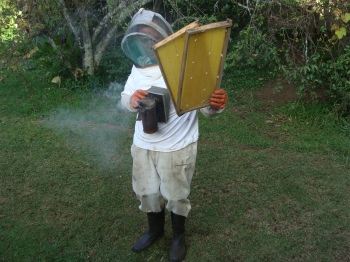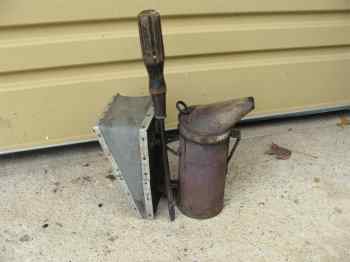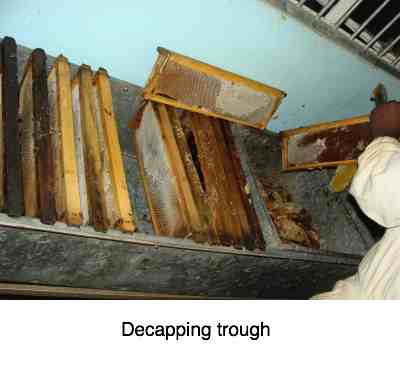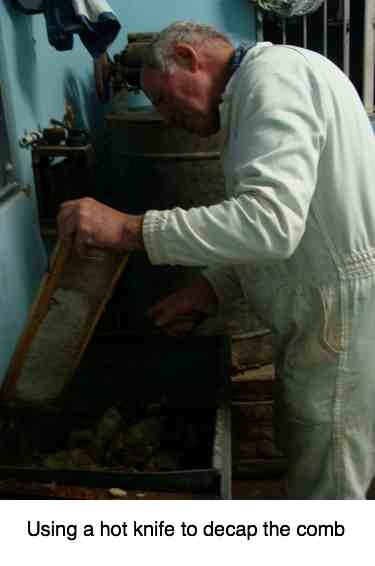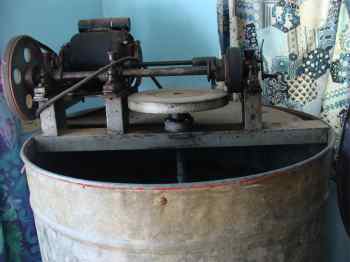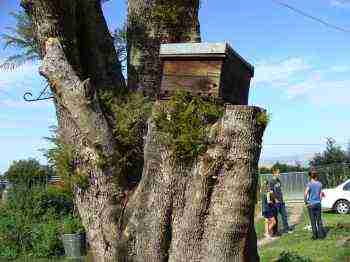- Bernard Preston homepage
- Beekeeping
- Beekeeping Equipment
Beekeeping equipment
Beekeeping equipment covers what you need to start an apiary. Obviously everything depends on how many hives you plan to have; a minimum of three is often recommended.
From three strong hives you can expect to get 150 or more pound jars of honey in a good season.
|
This page was last updated by Bernard Preston on 9th January, 2023. |
Reviewed by Derek A. Lewis, beekeeper |
Whilst beekeeping is a relatively inexpensive hobby, the startup costs are fixed, whether you have one hive or ten. You cannot avoid purchasing a veil, overall, and gloves; boots and a smoker too.
If you have only one hive, and you plan to enjoy only comb honey, then there are no other big costs.
Once you have over 5 to 10 hives, you will need more equipment. A settling tank and an extractor become mandatory; and a hot knife, scraper fork or spiked drum to open the combs, and perhaps a decapping trough too.
That is when it requires a little investment. Having said that, I am still using these same four more expensive items that I bought forty years ago. Only one small bearing on the extractor has needed replacing; now with this update, a second time. Oh, and if you are going to get serious about it, you will need a honey room.
Of course during much of the year, it is just a storeroom.
The honey flow starts in South Africa in March. It occurs oddly in the autumn and early winter when the eucalyptus trees flower. It is time to place to fresh new sheets of foundation in each hive. The queens are laying madly, and the new wax makes space for the increasing brood nest.
How I loved giving the grandchildren, only 5 and 3 their first lesson in beekeeping. A small chunk of drone cells provided eggs, larvae in various stages of development, and capped pupae. This is the hobby of a lifetime; over sixty years in my case. And how their eyes lit up on tasting honeycomb for the first time.
So, what are the basic costs?
Beekeeping equipment
Beekeeping equipment includes an overall, smoker, a veil and a sturdy screwdriver, or hive tool.
Veil
There are many different veil designs, each has its
advantages and disadvantages. It's certainly (in South Africa anyway)
should be sewed onto an old, very large, thick T-shirt. Our bees are mean, and
if there's a way in, they'll find it. Safe beekeeping equipment is vital.
This was one was made by she-who-must-be-obeyed. Perhaps in due course we'll look for a pattern, but I suspect it may be buried very deep since our seven year Dutch sojourn.
There are a few bee-whisperers around who talk to their bees in sweet tones. For the rest of us a veil is vital, certainly if you are dealing with African killer bees. I can't verify it, but someone told me that bees kill more people in South Africa than all the other animals put together. Frankly I have my doubts, the mosquito and malaria must surely have that record. Or is it humans? They kill 30 000+ people every year...
In any event my advice is to wear a bee-proof veil.
Cost: R695 - R1372 ($49-97)
PS. These are 2018 prices in South Africa. You can bank on the fact that they rise about 10 percent year.
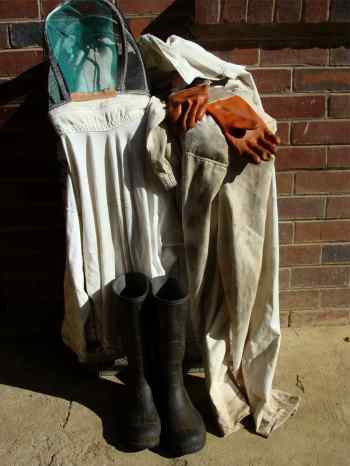
OVERALLS
The overall should be heavy-duty (thick material), white (dark colours make the bees more aggressive), with a zip, and must be OVER-SIZED. Big! It must be loose because when you bend, if the overall is tight against the skin, the bees can and will sting through the overall.
Make sure the pockets are sewed up. You do not want angry bees down yonder!
In South Africa, cost is R558; about $39.
Gloves
Gloves with a gauntlet are essential. I recommend plastic rather than leather, although some folk swear by pigskin. The latter are more comfortable initially, but once they've been covered with honey a few times they become hard and you lose the finer movements. Plastic gloves are easy to wash.
Cost: R163 ($11.50)
Gumboots
White gumboots, the sort that a dairyman would use are the best, up to just below the knee. The ankles and lower leg are an area that bees like to nail. Two pairs of socks is mandatory.
First put on the overall, tuck the trouser legs into thick socks, and then put the boots on over the overall. You won't get stung.
Note that under the overalls, you wear tracksuit trousers which are tucked into the first pair of socks. Then the overalls are tucked into the second pair of socks, before putting on your gumboots.
Make sure you buy gumboots that are oversized; otherwise they are very difficult to get off with the extra socks.
I now have white boots; new photo to follow.
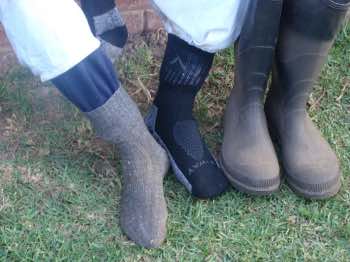
Cost: R110
Smoker
A smoker is the next vital tool when discussing beekeeping equipment. Smoke from pine needles, cardboard or egg boxes serves to calm the bees when they get wild. NEVER WORK WITH BEES WITHOUT THIS VITAL PIECE OF EQUIPMENT, AND MAKE SURE IT'S BURNING PROPERLY.
Cost: R587 ($41)
Tip 1: Always open the lid when you are finished using your smoker; there's resin from the burning material that cools and glues the lid closed otherwise.
Tip 2: Periodically poke a screwdriver down the hole where the smoke comes out. It too gets clogged with resin.
SCREW-DRIVER / Hive tool
You can purchase a special "hive tool" for R120 but I also like a good strong screw-driver. This tool is used for prizing the hive open and removing frames. A little pocket for both a hive tool and a screw-driver is better still. They easily get lost in long grass, so choose a tool with a bright colour. I'm red-green colour blind, so a red screwdriver in green grass....
WAX EMBEDDER
A small roller to imbed the wire into the wax foundation sheets is a vital little piece. Inexpensive. WAXING HONEYBEE FRAMES ...
An alternative, not a bad one, is to have a small 12V battery with connecting wires and crocodile clips. Heating the wire imbeds it nicely into the wax with a little practice.
TOTAL
So, about R3,000 ($210) will buy all the accessories you need to make a start with your beekeeping. Obviously prices in other countries will vary.
OTHER EQUIPMENT
If you have five or less hives, and another friendly beekeeper in the neighbourhood, you can probably get away without further equipment.
However, once you get to more than five hives, you'll want a honey-extractor to remove the honey. A small hand-operated extractor costs R7000 ($500+) and a large electric operated extractor like mine R35,000 ($2500). It is an essential piece of equipment, since you probably want your honey in bottles.
The trend these days is to hire a honeyroom for the day so you don't need to purchase this expensive equipment initially.
A settling tank with a honey-tap is quite important too. We'll get on to why and what this does later. I can't find a price, but say R2500.
Uncapping forks, electric de-capping knives, de-capping troughs... strainers. Yes, there are a variety of small items you will need.
GRAND TOTAL
Five hives @ R817 = R4080 (there are some little extras)
Twenty sheets of brood foundation wax @ R30 = R400/ hive
Veil etc R 1,100
Extractor R4300
Settling tank R1500
Decapping knives and other incidentals, R500
TOTAL = R15,000 will get you started.
Almost
all of the above can be picked up by a shrewdy for a fraction of that
price. People make a start, and then give up for one reason or another.
Beekeepers die and their children aren't always interested. Mine
are not, but I am hoping my grandchildren will take after their beloved
Ba! But they're only 4, 8 and 10! Already they do most of the bottling.
Bees wax is a byproduct of beekeeping. The money laid out on foundation you'll get back in the first honeyflow.
A settling tank is an optional extra; it certainly makes everything easier and cleaner, but you don't need to start there.
This may seem like a lot of money to lay out before even starting; to put things into perspective, I have just harvested in the last month 330 pound jars of top quality honey from nine hives, and the flow is not yet over; you do the maths.
A hot knife (electrical) is used to "decap" the combs. Each cell is a small bottle, with a wax lid to seal. Before the honey can be extracted the capping have to be removed. Today I prefer a fork or roller; quicker and the honey is not exposed to any heat.
Jup that's me; 2020 is the sixty-year anniversary of my first hive. The hobby that has kept me enthused for a lifetime.
And the decapped combs go into this "extractor", actually just a centrifuge that removes the honey from the combs.
Honey bee farming
Honey bee farming is physically tough, but supremely rewarding. The environment is in dire need of those who are not shy of a hard day's work.
Once you have more than say ten hives, and are planning on a hundred plus, then you certainly need more sophisticated equipment.
Make your own hives
Those with carpentry skills and tools often make some of their hives, particularly the bottom-board, brood chambers, supers and lids. Marine ply is often used, and then hot dipped in an industrial wax.
Use 1 5/8" black #8 screws.
Raw honey
Raw honey and the processed stuff you buy in the supermarket are chalk and cheese; this is the low GI choice food you get when you start delving into beekeeping equipment.
On the left, fresh honey straight from the hive; on the right it has been left for a month, and starts to crystallise into the solid form; in my opinion it is even better. Doesn't run off the toast and drip all over your plate.
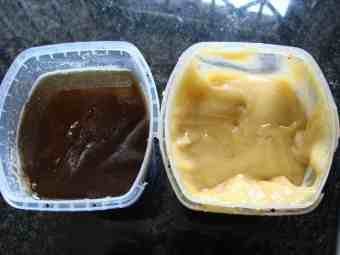
The empty combs then go straight back on the hive, for the bees to refill with nectar. The raw honey you keep!
Here are a few interesting facts about honey bees.
One honeybee can collect enough nectar to make only one twelfth of a teaspoon of honey in its whole lifetime. Twelve bees to make one teaspoon of honey.
On average, each bee makes about ten trips per day. To make a half kilogram jar which is slightly more than one pound of honey, bees must fly nearly 100,000km and visit 2,000,000 flowers.
Their value
as pollinators greatly exceeds their importance in producing honey. Without bees there would be no almond crop and fruits like plums and peaches would have much smaller yields.
Honey and pollen are their sources of energy. Honey for carbohydrate, pollen for protein and fatty acids.
Newsletter
Our newsletter is entitled "create a cyan zone" at your home, preserving both yourself and Mother Earth for future generations; and your family too, of course. We promise not to spam you with daily emails promoting various products. You may get an occasional nudge to buy one of my books.
Here are the back issues.
- Investing in long-term health
- Diseases from plastic exposure
- Intensive lifestyle management for obesity has limited value
- A world largely devoid of Parkinson's Disease
- The impact of friendly bacteria in the tum on the prevention of cancer
- There's a hole in the bucket
- Everyone is talking about weight loss drugs
- Pull the sweet tooth
- If you suffer from heartburn plant a susu
- Refined maize meal and stunting
- Should agriculture and industry get priority for water and electricity?
- Nature is calling
- Mill your own flour
- Bake your own sourdough bread
- Microplastics from our water
- Alternative types of water storage
- Wear your clothes out
- Comfort foods
- Create a bee-friendly environment
- Go to bed slightly hungry
- Keep bees
- Blue zone folk are religious
- Reduce plastic waste
- Family is important
- What can go in compost?
- Grow broad beans for longevity
- Harvest and store sunshine
- Blue zone exercise
- Harvest and store your rainwater
- Create a cyan zone at your home
A strong colony may contain 50,000 bees.
If half of them are foragers then one hive will pollinate 250,000 flowers in a day.
Honeybees
contribute 90 percent of the pollination to crops. Beehives placed for
example in a sunflower crop will increase the yield by 30 percent.
Beekeepers use honey bee traps to catch wild swarms. The best beekeeping equipment in the world, without bees is quite useless. Obviously. So how do go about catching bees? You use honey bee traps which you can set up on a roof or tank.
How to start beekeeping
How to start beekeeping is not rocket science, but do begin with some good equipment; getting badly stung through the use of a poor veil or gloves in the early days is not helpful.
Once you have acquired your basic equipment, what you need is some bees.
Bee traps
Honey bee traps are a way to expand your apiary, but it only applies in countries with indigenous colonies that swarm regularly.
Solar wax extractor
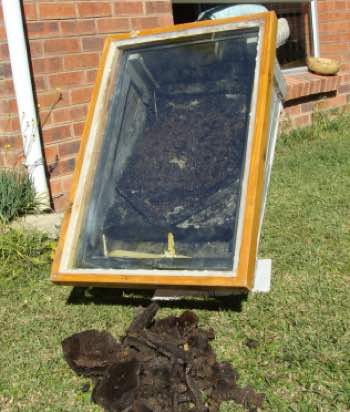
A solar wax extractor is not part of basic beekeeping equipment. You'll probably start by using a pot with boiling water to melt the wax and then strain off the crud. It is perfectly effective, but watch it like a hawk, or it will boil over on your stove and make an awful mess.
Far better it a beeswax solar extractor that you'll probably have to make yourself. It uses the sun's energy, and you'll have zero mess.
choice foods
I cannot recommend that from the supermarket as one of the choice foods. Being a heat and light labile product it is easily spoiled. But once you have your own beekeeping equipment, or know a local keeper then you are half way to the land of milk and honey.
Retirement sentiments questions how wise it is to start thinking about putting your feet up? Retire and expire are the norm for so many men.
Type retirement sentiments into Site Search in the main menu above.
Links
GLYCEMIC INDEX
I used to think that honey would have an extremely high glycemic index; it's obvious, eh, consisting largely of glucose and fructose. Obvious and quite wrong; as has been said, the word "assume" can make an ass out of you and me. My apologies if I misled you.
Honey is not even in the high GI group; but supermarket honey is on the border between the moderate and low groups. No one to my knowledge has tested just where pollen-rich honey lies; because pollen is where the bees get their protein and fatty acids from, it's logical to assume that lightly filtered, raw honey has a low glycemic index.
Nevertheless, because colas and chocolate, white bread and white rice, and even raw honey, all on their own, carbohydrates are not satisfying, I would prefer to see you enjoy your honey on a bread and cheese sandwich. Refined carbs tend to give you an insulin surge, and is immediately turned first to glucose and then to fat, unless you get sneaky.
Carbohydrate Count Chart and Glycemic Index; learn more about combining nutritious foods.
Bernard Preston
Bernard Preston is actively involved in beekeeping equipment; a small veil lives permanently on the verandah and is sometimes useful when picking the greens for lunch. Bees can get uppity in the middle of the day, or one of the many thousands taking off for the fields might accidentally bump into you.
Did you find this page interesting? How about forwarding it to a friend, or book and food junkie? Better still, a social mead tick would help.
- Bernard Preston homepage
- Beekeeping
- Beekeeping Equipment
Address:
56 Groenekloof Rd,
Hilton, KZN
South Africa
Website:
https://www.bernard-preston.com
